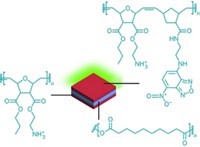Advertisement
Grab your lab coat. Let's get started
Welcome!
Welcome!
Create an account below to get 6 C&EN articles per month, receive newsletters and more - all free.
It seems this is your first time logging in online. Please enter the following information to continue.
As an ACS member you automatically get access to this site. All we need is few more details to create your reading experience.
Not you? Sign in with a different account.
Not you? Sign in with a different account.
ERROR 1
ERROR 1
ERROR 2
ERROR 2
ERROR 2
ERROR 2
ERROR 2
Password and Confirm password must match.
If you have an ACS member number, please enter it here so we can link this account to your membership. (optional)
ERROR 2
ACS values your privacy. By submitting your information, you are gaining access to C&EN and subscribing to our weekly newsletter. We use the information you provide to make your reading experience better, and we will never sell your data to third party members.
Environment
Five-Second Red Herring
August 20, 2007
| A version of this story appeared in
Volume 85, Issue 34
Newscripts reported on research by Paul L. Dawson and colleagues at Clemson University (J. Appl. Microbiol. 2007, 102, 945) as testing the so-called five-second rule: that is, if you drop food on the floor and pick it up within five seconds, it will be okay to eat (C&EN, June 18, page 80). A recent New York Times column by Harold McGee quoted the same study.
But the Clemson study proves nothing at all about the "rule." In fact, any such rule is inherently a red herring, because it is based on a false premise.
The unspoken hypothesis seems to be that bacteria on the floor are like tiny grasshoppers that leap onto the food as soon as it lands like manna from Microbe Heaven. However, several hundred years of microscopic examination have failed to reveal any legs, trampolines, or pogo sticks in the possession of bacteria, viruses, or spores. Trying to foil them by snatching the food away before the entire flock has had a chance to hop aboard is sheer folly.
A few seconds' thought will show that time has nothing to do with how many microbes will contaminate the dropped food. Where do the bacteria reside on a contaminated surface? They are entrapped in what we define as dirt or, more politely, in some sort of sustaining "biofilm." The amount of this dirt, and hence the number of bacteria that will adhere to a dropped slice of bologna, depends only on the area of contact and the mutual stickiness between the dirt and the bologna. These are not time-dependent qualities.
Not surprisingly, the Clemson researchers found that "food contact time had no effect on the percentage of [bacteria] transferred. ... Over 99% of bacterial cells were transferred from the tile to the bologna after five seconds of bologna exposure to tile." They didn't check any times below five seconds. Furthermore, "transfer from carpet to bologna was very low (less than 0-5%) when compared with the transfer from wood and tile (5–68%)." This is undoubtedly because the area of contact increases with surface smoothness, from carpet to wood to tile.
I am not criticizing the Clemson scientists. The main purpose of their research was to find out how long bacteria remain viable on various surfaces such as carpets and wooden or tile floors. Only incidentally did they measure the amounts of bacterial transfer onto slices of bologna and white bread placed on these contaminated surfaces. What I am criticizing is the assumption-tacitly accepted even by scientists-that the five-second (or 10-second or whatever) rule is subject to scientific proof or disproof by measuring times.
Is there a moral for all scientists in this? Absolutely. Before designing an experiment to determine the dependence of X on Y, make sure you have good reason to believe that Y does indeed have an effect on X. In other words, don't go chasing phantom variables.
Now if you'll excuse me, I must return to my laboratory to measure the contamination of bologna sandwiches when dropped onto the floor during different phases of the moon.
Robert L. Wolke
Pittsburgh




Join the conversation
Contact the reporter
Submit a Letter to the Editor for publication
Engage with us on Twitter